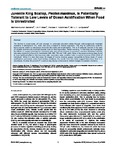Juvenile king scallop, Pecten maximus, is potentially tolerant to low levels of ocean acidification when food is unrestricted.
| dc.contributor.author | Sanders, MB | en |
| dc.contributor.author | Bean, TP | en |
| dc.contributor.author | Hutchinson, TH | en |
| dc.contributor.author | Le Quesne, WJF | en |
| dc.date.accessioned | 2017-05-17T08:48:58Z | |
| dc.date.available | 2017-05-17T08:48:58Z | |
| dc.date.issued | 2013 | en |
| dc.identifier.uri | http://hdl.handle.net/10026.1/9263 | |
| dc.description.abstract |
The decline in ocean water pH and changes in carbonate saturation states through anthropogenically mediated increases in atmospheric CO2 levels may pose a hazard to marine organisms. This may be particularly acute for those species reliant on calcareous structures like shells and exoskeletons. This is of particular concern in the case of valuable commercially exploited species such as the king scallop, Pecten maximus. In this study we investigated the effects on oxygen consumption, clearance rates and cellular turnover in juvenile P. maximus following 3 months laboratory exposure to four pCO2 treatments (290, 380, 750 and 1140 µatm). None of the exposure levels were found to have significant effect on the clearance rates, respiration rates, condition index or cellular turnover (RNA: DNA) of individuals. While it is clear that some life stages of marine bivalves appear susceptible to future levels of ocean acidification, particularly under food limiting conditions, the results from this study suggest that where food is in abundance, bivalves like juvenile P. maximus may display a tolerance to limited changes in seawater chemistry. | en |
| dc.format.extent | e74118 - ? | en |
| dc.language | eng | en |
| dc.language.iso | eng | en |
| dc.subject | Animal Feed | en |
| dc.subject | Animals | en |
| dc.subject | Carbon Dioxide | en |
| dc.subject | DNA | en |
| dc.subject | Energy Metabolism | en |
| dc.subject | Hydrogen-Ion Concentration | en |
| dc.subject | Intracellular Space | en |
| dc.subject | Pecten | en |
| dc.subject | RNA | en |
| dc.subject | Seawater | en |
| dc.subject | Time Factors | en |
| dc.title | Juvenile king scallop, Pecten maximus, is potentially tolerant to low levels of ocean acidification when food is unrestricted. | en |
| dc.type | Journal Article | |
| plymouth.author-url | https://www.ncbi.nlm.nih.gov/pubmed/24023928 | en |
| plymouth.issue | 9 | en |
| plymouth.volume | 8 | en |
| plymouth.publication-status | Published online | en |
| plymouth.journal | PLoS One | en |
| dc.identifier.doi | 10.1371/journal.pone.0074118 | en |
| plymouth.organisational-group | /Plymouth | |
| plymouth.organisational-group | /Plymouth/Research Groups | |
| plymouth.organisational-group | /Plymouth/Research Groups/BEACh | |
| plymouth.organisational-group | /Plymouth/Users by role | |
| dc.publisher.place | United States | en |
| dcterms.dateAccepted | 2013-07-31 | en |
| dc.identifier.eissn | 1932-6203 | en |
| dc.rights.embargoperiod | Not known | en |
| rioxxterms.versionofrecord | 10.1371/journal.pone.0074118 | en |
| rioxxterms.licenseref.uri | http://www.rioxx.net/licenses/all-rights-reserved | en |
| rioxxterms.licenseref.startdate | 2013 | en |
| rioxxterms.type | Journal Article/Review | en |


